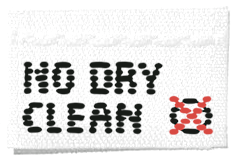Professional wet cleaning continues to grow as a popular service offered by clothes cleaners, and as a healthier substitute to the use of dry cleaning chemicals. Professional wet cleaning is a water-based, nontoxic, energy-efficient technology that uses computer-controlled washers and dryers, specially formulated biodegradable detergents, and specialized finishing equipment to process garments that are otherwise dry cleaned.
Professional wet cleaning is the most accessible of the alternatives to dry cleaning because the equipment used is affordable to small businesses. Wet cleaning uses water and biodegradable detergent in special equipment that washes clothes very gently and sets a specific humidity level for the drying process. Also, special pressing and tensioning equipment is utilized to prevent shrinkage and maintain garment shape. Wet cleaning can be used on most garments labeled “dry clean only.”
Frequently Asked Questions about Wet Cleaning
What is wet cleaning?
Professional wetcleaning is an alternative to dry cleaning. It is a solvent-free method to care for garments. Professional wet cleaners use specialized equipment to safely clean in water those garments previously cleaned in chemical solvents.
What are the benefits of wet cleaning?
Wet cleaning is better for the environment and better for your health. There is no chemical smell from off gassing dry cleaning solvents. Wet cleaning produces whiter whites and is often more
effective in removing water-based stains.
What are the risks of wet cleaning?
Because water is used in the process, it is possible that wetcleaning may cause shrinkage or color changes. Wet cleaning may also not be effective in removing grease-based stains.
What are the environmental effects of wetcleaning?
Wetcleaning does not require hazardous chemicals, avoiding environmental harm to the air, water and soil. With the exception of increased use of water, wet cleaning is profoundly better for the environment than dry cleaning. The wetcleaning process is not a significant concern to wastewater treatment officials.
How much does wet cleaning cost?
Wetcleaning is generally comparably priced to dry cleaning. Wetcleaning requires increased labor costs but reduced expenses for chemicals and chemical disposal. It is important to patronize wetcleaners because as demand rises, it is reasonable to expect that economies of scale will bring about lower prices in the future.
What type of clothes can be wetcleaned?
Clothes that can be wetcleaned include cottons, wools, silks, suedes and leather. Wet cleaning can also be suitable for fragile garments such as beaded and sequined fabrics, wedding dresses and fine suits.
What type of clothes should not be wetcleaned?
Although it is always a good idea to check with the wetcleaner, garments that may be difficult to wetclean include: acetate linings, highly tailored wools, antique satins and garbardines.
